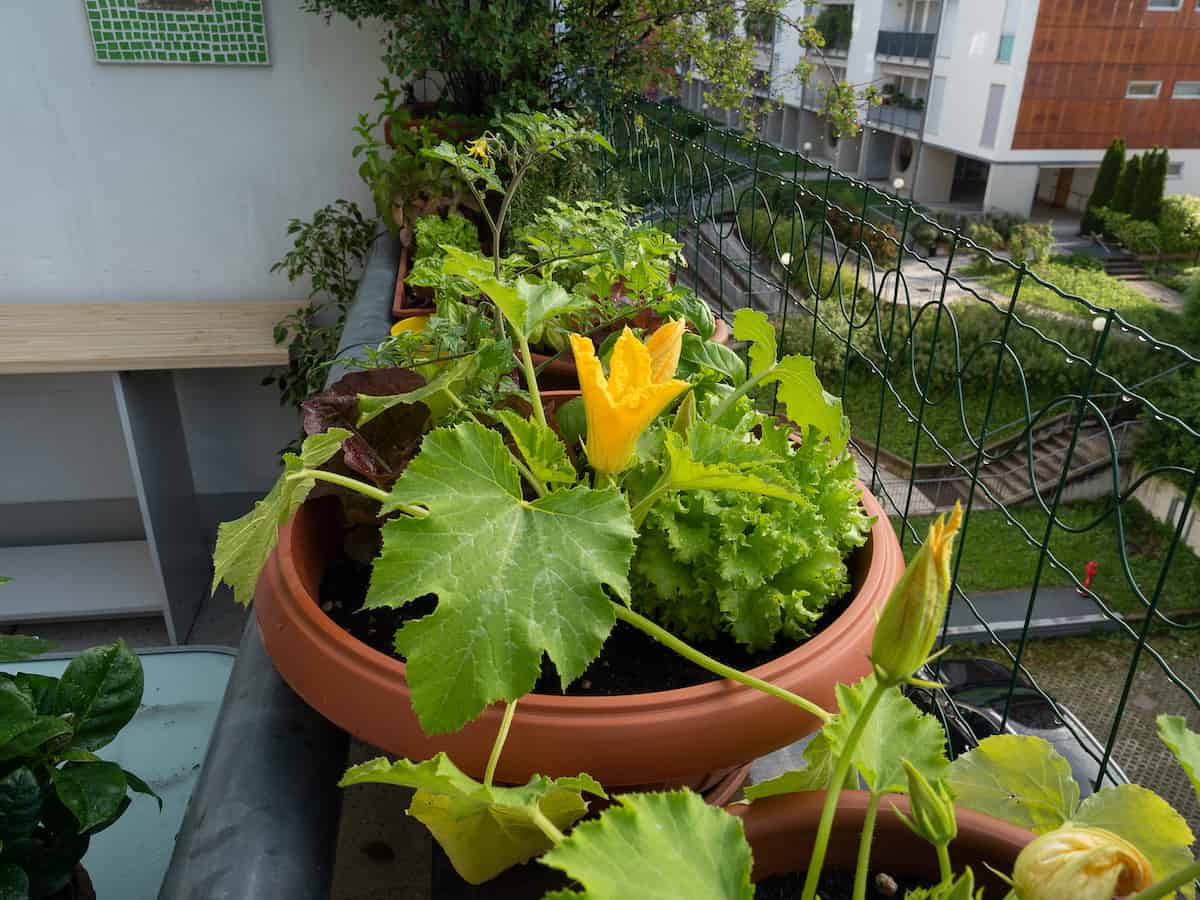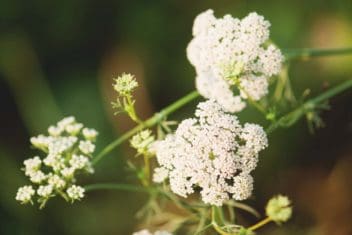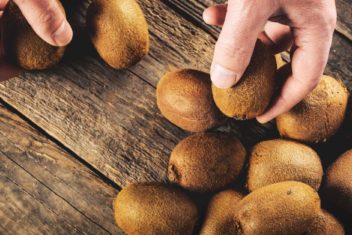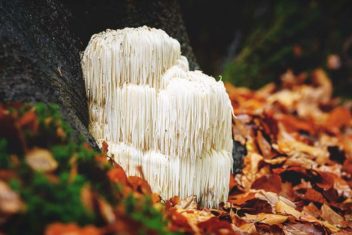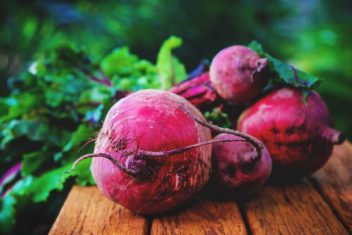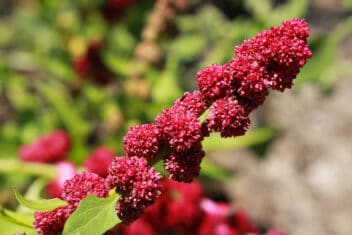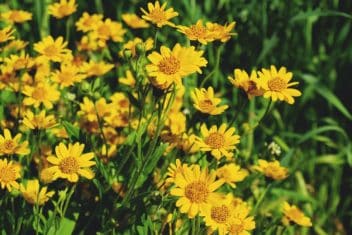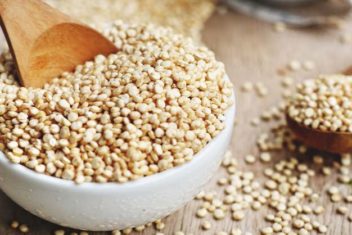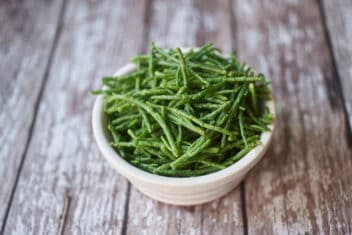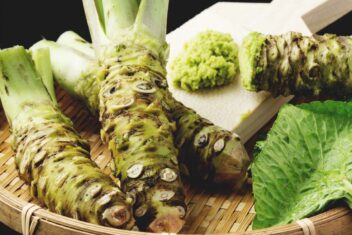Zucchini is a common sight in the soil, but you don’t see it in pots as much. But growing zucchini in a container is a great way to get your summer zucchini fix because the pot keeps it contained, you can move it around to catch the sun and keep a good airflow through the plant.
Zucchini is a popular plant that practically everyone tries to grow at some point because it’s so prolific. It just keeps on giving right through summer and into fall.
But not everyone has the space. If you love zucchini, try it in a container and you will be amazed at how well it adapts.
Why Grow Zucchini in a Container?
If you don’t have the garden space for a full zucchini plant, a container is totally the way to go. Container growing lets you expand your gardening options without expanding your space.
If you’ve always grown zucchini in the garden, but you’re just starting out with container growing, zucchini is a smart place to start. They’re reliable, fast-growing, and very forgiving.
Plus, a container makes it so that you can keep your plant right outside your door, so you have a convenient way to pluck the fresh fruits as you need them. You’re far less likely to miss those zukes that end up turning into baseball bats with a container plant, as well.
Best Zucchini Varieties for Containers
There are so many varieties of zucchini, there’s one for every gardener, including sizes tailor-made for container growing.
You could grow any zucchini variety in a container, but the best ones are the bush variety or the ones bred specifically for containers. They often have “patio” or “baby” in the name. The vining varieties are better suited for the garden because they spread out in all directions.
Buckingham Patio
Bred specifically for containers, this variety only grows to about 12 inches tall. It will spread out about 4 feet, so a large pot is needed. You will get a lot of yellow fruit from ‘Buckingham patio’ after about 40 days.
Astia
This is a French bush variety bred for containers. About 48 days will see you plucking fruit that forms at the base of the plant for easier harvesting.
Bush Baby
Another compact variety that tops out at no more than 24 inches tall. The fruits are 6 inches long and mature in 59 days.
Patio Star
‘Patio star’ is a compact variety, but grows a lot of fruit. It’s just 2 feet tall and 3 feet wide, but you will get a huge harvest in about 40 days.
Tender Grey
One of the taller container varieties at 36 inches tall, you may need to trellis this one to support the amount of fruit it produces. Matures in 45 days.
Cue Ball Zucchini
A round zucchini, ‘cue ball’ (also known as ‘eight ball’) is one of the bigger varieties for containers, but suitable for trellising. It’s ready to pluck in 40 days.
Gold Rush
Another bigger variety for containers, but worth the effort. You will get lots of yellow fruit about 8 inches long. May need trellising. Ready in 45 days.
How to Plant Zucchini in Containers
Zucchinis grow just about anywhere. They do well in zones 2 to 12 and you can move the pots around to follow the sun if necessary.
Zucchini loves sunlight. Give plants direct sunlight for a minimum of 6 to 8 hours a day, if not more.
Use a good quality, well-draining potting medium. It should have perlite or vermiculite added to retain water. A good quality mix will have water retention crystals or sustained released fertilizer. A pH of 6 to 6.8 is best.
When to Plant
The optimal soil temperature for zucchini is 60°F to 75ºF. Plant in mid-spring because zucchini does not like frost. If you’re able to move your containers around, plant early spring and bring them into a protected area if you get a late frost.
Planting Seed
Plant seeds inside in early spring, 8 weeks before the last frost. Use seed raising mix in a large pot. Zucchini seeds germinate rapidly and if you use too small of a container, the roots will protrude from the bottom quickly.
A half gallon container is ideal.
Keep the soil moist with a spray bottle and within 7 days the seeds should germinate and your new zucchini will be well on its way.
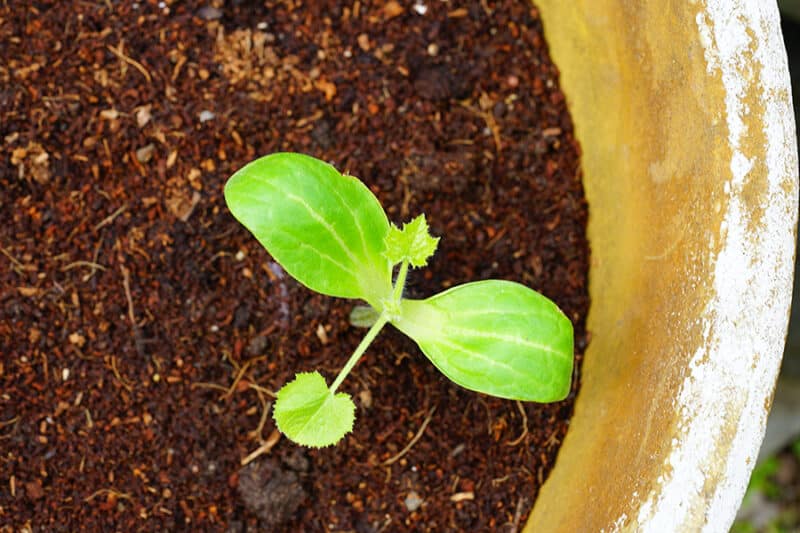
Planting Seedlings
To save time, you can buy seedlings from a nursery, but make sure you get one specifically for containers or patios. A large garden variety will struggle in a container over a season of growing due to its big root system.
Spacing
My preference is one zucchini per 5 gallon container, but bigger is always better.
Container Selection
What do you consider a container? I’ve grown zucchini in 5-gallon buckets with holes in the bottom and I’ve grown it in half wine barrels cut lengthways. Really, anything large enough and sturdy enough to last the growing season will do.
Choose a container with good drainage and sturdy sides and bottom. Even small zucchini have strong roots.
The bigger the container, the more zucchini. At a minimum, no more than one plant per 5-gallon volume. Remember, if you need to move your zucchini around in their containers, you can’t have them too big.
If you have space, separate 5 gallon containers with one plant each is best.
Because zucchini is water greedy, I prefer a plastic or cement container because it retains water better. Terra cotta tends to dry out faster.
Caring for Zucchini in Containers
If you pay attention to water and feeding, you should have no trouble growing zucchini in containers.
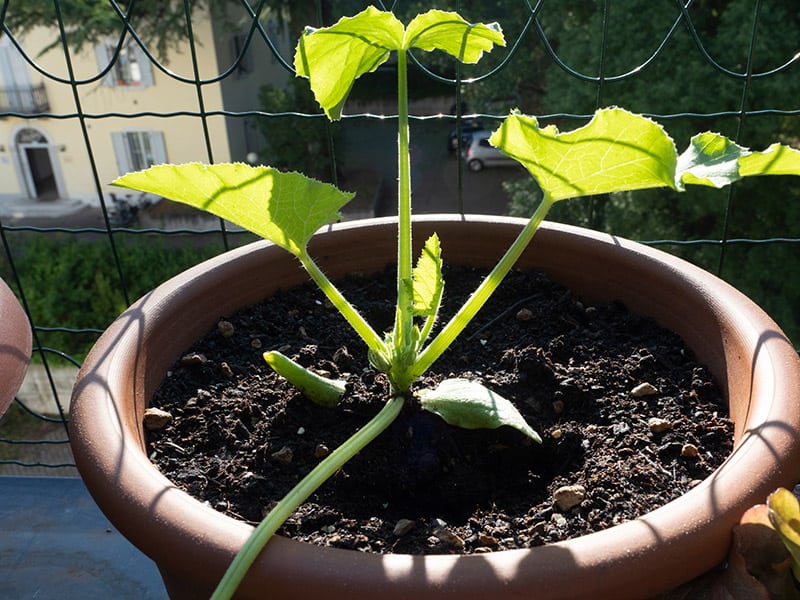
Fertilizer
Mix a sustained/time-release fertilizer in the container when you first plant. Remember to check how long that will last. Alternatively, use a liquid fertilizer containing seaweed or fish extract once a month.
Water
Zucchini in containers require a fine balance of well-draining potting mix that can retain moisture and regular watering. Water well when the top 2 inches of the soil is dry. Water the potting mix, not the plant.
Pruning
The leaves and stalks of zucchini often die off, especially if they get damaged. Remove them if that’s the case, but there’s no need to actively prune. Zucchini stems don’t heal especially well when cut, so pruning for shape will open up too many points of disease entry for the plant.
Pollinating
It can be a little more challenging for zucchini growing in containers to get pollinated. That’s because there may not be as many bees around. If you notice tons of bees visiting your plant, no need to worry.
But if you don’t see bees, or the blossoms fall off your plant without any fruits forming, you need to do some hand pollination. Our guide will walk you through the steps.
Companion Planting for Zucchini in Containers
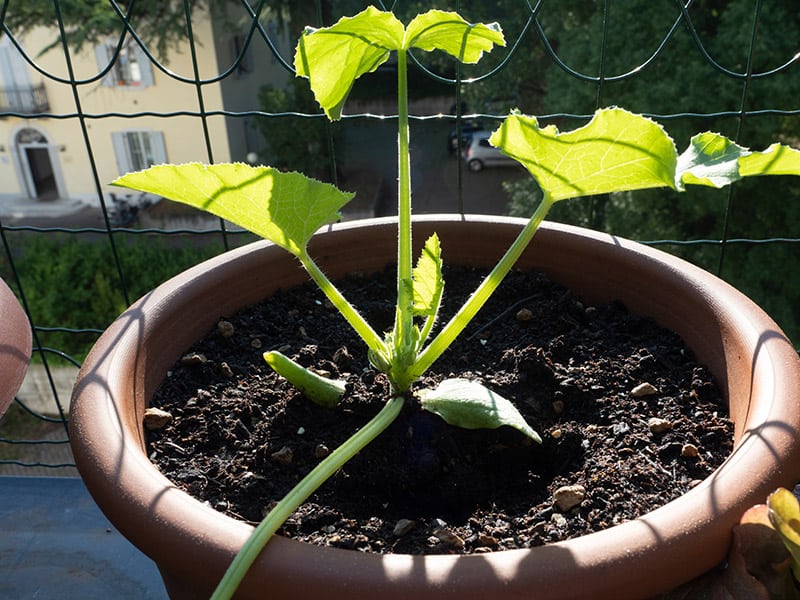
Consider planting fast-growing plants in the container with zucchini if you want more than one plant in the same pot. Try these plants in the same container as the zucchini:
- Radish
- Parsley
- Marjoram
- Marigold
Try these in neighboring containers:
- Nasturtium
- Dill
- Peppermint
- Mint
- Garlic
Common Problems and Solutions for Growing Zucchini in Containers
One of the nice things about growing zucchini in containers is that you can avoid some of the soil-borne diseases that zucchini in the ground suffers from. Still, there are a few things to watch out for.
Powdery Mildew
This is the most common issue with zucchini in the garden. The grey powder that forms on the leaves is a result of moisture and lack of airflow.
It can be avoided in containers by moving the container to get maximum airflow, planting one zucchini per container, and watering directly to the potting mix.
If you notice leaves with mildew, remove them with a sharp knife at the base and throw them in the garbage. You can also spray plants with a 1:1 mix of milk and water.
Bacterial Wilt
Spread by the cucumber beetle, this is a death sentence for your zucchini. If your plant starts to wilt and die off for no obvious reason, and you’ve given the plant plenty of water, bacterial wilt is probable.
Remove the whole plant and throw it in the garbage. Sterilize containers and don’t use them again for one season.
Blossom End Rot
Blossom end rot usually indicates a calcium deficiency along with inconsistent watering. If you’ve grown tomatoes through a dry period and not watered sufficiently, you will have seen this. The fruit rots at one end and it’s impossible to control once it starts.
Water well and ensure the plant is fed regularly.
Cucumber Beetle
Yellow and black stripes on their back give these beetles away. They love zucchini and if there are any beetles around, they will find your plants.
Use regular monthly sprays of neem oil mixed with organic pyrethrum. See the instructions on your brand as the usage amount varies.
If you don’t want to spray, you can pick them off with gloves and squash them.
Squash Bugs
These shield-shaped pests will kill a zucchini plat given half a chance. They eat their way through the foliage and weaken the plant until it dies. Keep the base of the plant clear of debris because that’s where the squash bug hides at night.
You will likely notice their eggs first, laid neatly in rows on the undersides of the leaves. Squash them when you find them.
If you have an adult infestation, it’s likely you’ll have to use strong pesticides like carbaryl.
Harvesting Zucchini
Pick your zucchini fruit regularly and the plant will keep gifting you more. Try not to let them overgrow on the plant.
It’s okay to let zucchini overgrow in the garden plants because some people want the zucchini to grow into a marrow. But it’s damaging to the zucchini in a container because it sucks up valuable nutrients needed for continued fruit production.
Pick your zucchini just before they reach the recommended harvest size. Smaller zucchini has more taste than if you let them grow past their harvest size when they become a little tasteless.
